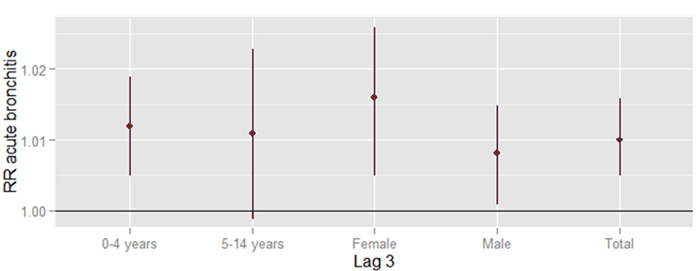| Follow @co2science |
Paper Reviewed
Xie, M., Ni, H., Zhao, D., Cheng, J., Wen, L., Li, K., Yang, H., Wang, S., Zhang, H., Wang, X. and Su, H. 2017. Effect of diurnal temperature range on the outpatient visits for acute bronchitis in children: a time-series study in Hefei, China. Public Health 144: 103-108.
Introducing their work, Xie et al. write that acute bronchitis is "an inflammation of the large bronchi (medium-size airways) in the lungs that is mainly characterized by cough," adding that this malady "is one of the most common outpatient illnesses, with a higher incidence in the winter," possibly due to large and rapid swings in temperature that occur from the passage of weather systems. Thus, it was their design to investigate the relationship between acute bronchitis and diurnal temperature range (DTR), which they considered to be "a meteorological indicator closely associated with urbanization, global climate change and [reflective of] the stability of the weather."
To accomplish their goal, the eleven Chinese scientists examined 14,055 cases of acute bronchitis among children aged 0-14 in Hefei, China (the capital city of Anhui province in the eastern region of China with a population of over 7 million persons) over the winter months (December-February) of 2010 through 2013. More specifically, they applied a Poisson generalized linear regression model with a distributed lag non-linear model to the data in order to determine if there was any effect of the DTR on childhood bronchitis.
The results of their analysis indicated that the risk of bronchitis increased as the DTR increased, which relationship was greatest at a 3-day lag, where a 1°C increase in DTR led to a 1.0 percent increase in the number of daily cases for childhood bronchitis. Stratifying their analysis into categories of male vs female and early (0-4 years old) vs late (5-14 years old) childhood further revealed the relative risk was greater among females and young children aged 0-4 years (see figure below).
Of significance to Xie et al.'s findings is the fact that multiple researchers have reported a decline in DTR in recent decades at locations all across the globe in conjunction with a rise in global temperatures. In China, for example, Shen et al. (2014) recently calculated a country-wide DTR decrease at a mean rate of 0.157°C/decade based on an analysis of 479 weather stations over the period 1962 to 2011; and they cited the works of a number of other authors who also determined that the "DTR decreased significantly in China over the past several decades, including Karl et al. (1991, 1993), Kukla and Karl (1993), Dai et al. (1997, 1999), Liu et al. (2004), Ye et al. (2010), Zhou and Ren (2011), Wang and Dickinson (2013), Xia (2013) and Wang et al. (2014). Consequently, it would appear that if global temperatures continue to rise and the DTR continues to decline, there will likely be less cases of acute childhood bronchitis in the future.

Figure 1. The relative risk (RR) of DTR on childhood acute bronchitis at a 3-day lag. Source: Xie et al. (2017).
References
Dai, A., DelGenio, A.D. and Fung, I.Y. 1997. Clouds, precipitation and diurnal temperature range. Nature 386: 665-666.
Dai, A., Trenberth, K.E. and Karl, T.R. 1999. Effects of clouds, soil moisture, precipitation, and water vapor on diurnal temperature range. Journal of Climate 12: 2451-2473.
Karl, T.R., Kukla, G., Razuvayev, V.N., Changery, M.J., Quayle, R.G., Heim Jr., R.R., Easterling, D.R. and Fu, C.B. 1991. Global warming: evidence for asymmetric diurnal temperature change. Geophysical Research Letters 18: 2253-2256.
Karl, T.R., Jones, P.D., Knight, R.W., Kukla, G., Plummer, N., Razuvayev, V., Gallo, K.P., Lindseay, J., Charlson, P.J. and Peterson, T.D. 1993. Asymmetric trends of daily maximum and minimum temperature. Bulletin of the American Meteorology Society 74: 1007-1023.
Kukla, G. and Karl, T.R. 1993. Nighttime warming and the greenhouse effect. Environmental Science and Technology 27: 1468-1474.
Liu, B., Xu, M., Henderson, M., Qi, Y. and Li, Y. 2004. Taking China's temperature: Daily range, warming trends, and regional variations, 1955-2000. Journal of Climate 17: 4453-4462.
Shen, X., Liu, B., Li, G., Wu, Z., Jin, Y., Yu, P. and Zhou, D. 2014. Spatiotemporal change of diurnal temperature range and its relationship with sunshine duration and precipitation in China. Journal of Geophysical Research: Atmospheres 119: 13,163-13,179.
Wang, F., Zhang, C., Peng, Y. and Zhou, H. 2014. Diurnal temperature range variation and its causes in a semiarid region from 1957 to 2006. International Journal of Climatology 34: 343-354.
Wang, K. and Dickinson, R.E. 2013. Contribution of solar radiation to decadal temperature variability over land. Proceedings of the National Academy of Sciences USA 110: 14,877-14,882.
Xia, X. 2013. Variability and trend of diurnal temperature range in China and their relationship to total cloud cover and sunshine duration. Annals of Geophysics 31: 795-804.
Ye, J., Li, F., Sun, G. and Guo, A. 2010. Solar dimming and its impact on estimating solar radiation from diurnal temperature range in China, 1961-2007. Theoretical and Applied Climatology 101: 137-142.
Zhou, Y.Q. and Ren, G.Y. 2011. Change in extreme temperature events frequency over Mainland China during 1961-2008. Climatic Research 50: 125-139.
Posted 10 July 2017



